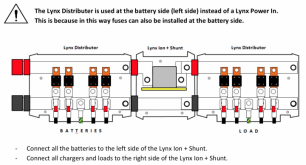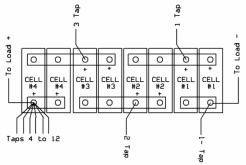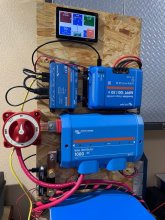hipringles
Solar Enthusiast
- Joined
- Jan 31, 2021
- Messages
- 214
I have (or will soon) have a 12V battery bank that has these 3 major loads:
1.) 75A (peak continous, 100A surge) 12V Air conditioner
2.) ~50-75A of misc 12V appliances (Water pump, heater, fans, lights, DC fridge, etc)
3.) 12V 3000W Victron inverter
I am trying to decide on the best way to connect these to the battery bank, and where the fuses should go... Here is what I think, and what am I questioning
1.) 4/0 Wire with 400A fuse between battery and inverter
2.) 0 or 2 gauge wire, 100A breaker between battery and Airconditioner
3.) 75A cb on 2 or 4 gauge wire to the fuse block from the battery
Thus 3 connections, all with their own breakers to the 3 major DC loads
Questions:
Q1.) How should I connect those 3 items to the battery bank? A bus bar would need to be a ~500A+ busbar? I am thinking possible 3 wires off battery positive? Or is a busbar required?
Q2.) Should there be no other loads between main inverter fuse and inverter (AKA, don't put item #3 on the output of the 400A inverter fuse)
Q3.) Negative return: I plan to have a 500A victron shunt, can I just attach the 3 main negatives back to this? Or is a 500A negative bar required, which then connects to the shunt? Could a smaller one be used?
Bonus:
Q4.) Cancel the 12V AC and spend the extra ~$700 to go 24V ?
?
1.) 75A (peak continous, 100A surge) 12V Air conditioner
2.) ~50-75A of misc 12V appliances (Water pump, heater, fans, lights, DC fridge, etc)
3.) 12V 3000W Victron inverter
I am trying to decide on the best way to connect these to the battery bank, and where the fuses should go... Here is what I think, and what am I questioning
1.) 4/0 Wire with 400A fuse between battery and inverter
2.) 0 or 2 gauge wire, 100A breaker between battery and Airconditioner
3.) 75A cb on 2 or 4 gauge wire to the fuse block from the battery
Thus 3 connections, all with their own breakers to the 3 major DC loads
Questions:
Q1.) How should I connect those 3 items to the battery bank? A bus bar would need to be a ~500A+ busbar? I am thinking possible 3 wires off battery positive? Or is a busbar required?
Q2.) Should there be no other loads between main inverter fuse and inverter (AKA, don't put item #3 on the output of the 400A inverter fuse)
Q3.) Negative return: I plan to have a 500A victron shunt, can I just attach the 3 main negatives back to this? Or is a 500A negative bar required, which then connects to the shunt? Could a smaller one be used?
Bonus:
Q4.) Cancel the 12V AC and spend the extra ~$700 to go 24V






